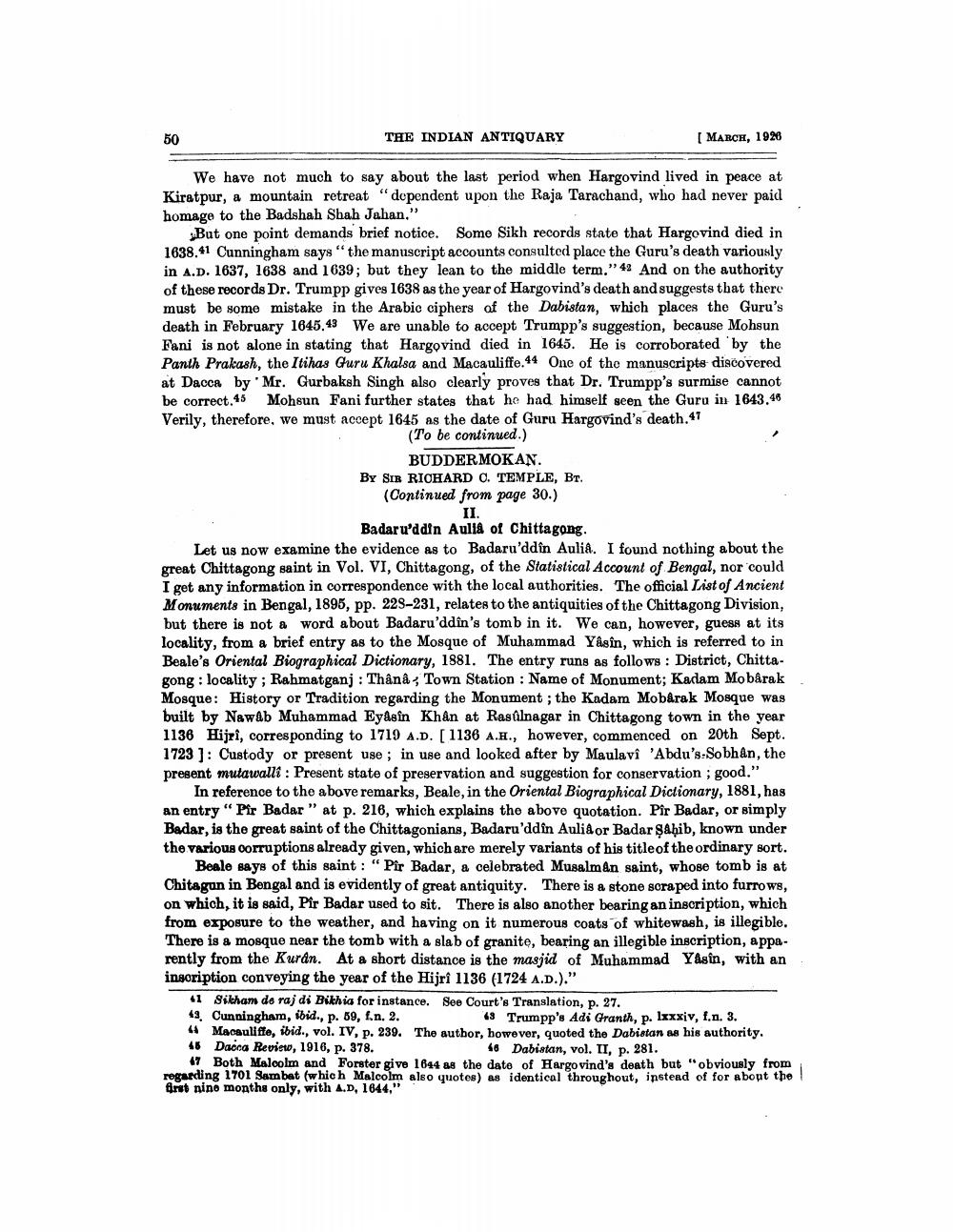________________
50
THE INDIAN ANTIQUARY
We have not much to say about the last period when Hargovind lived in peace at Kiratpur, a mountain retreat "dependent upon the Raja Tarachand, who had never paid homage to the Badshah Shah Jahan."
But one point demands brief notice. Some Sikh records state that Hargovind died in 1638.41 Cunningham says "the manuscript accounts consulted place the Guru's death variously in A.D. 1637, 1638 and 1639; but they lean to the middle term." 42 And on the authority of these records Dr. Trumpp gives 1638 as the year of Hargovind's death and suggests that there must be some mistake in the Arabic ciphers of the Dabistan, which places the Guru's death in February 1645.43 We are unable to accept Trumpp's suggestion, because Mohsun Fani is not alone in stating that Hargovind died in 1645. He is corroborated by the Panth Prakash, the Itihas Guru Khalsa and Macauliffe.44 One of the manuscripts discovered at Dacca by Mr. Gurbaksh Singh also clearly proves that Dr. Trumpp's surmise cannot be correct.45 Mohsun Fani further states that he had himself seen the Guru in 1643,46 Verily, therefore, we must accept 1645 as the date of Guru Hargovind's death.47
(To be continued.)
BUDDERMOKAN. BY SIR RICHARD C. TEMPLE, BT. (Continued from page 30.)
II.
Badaru'ddin Aulia of Chittagong.
[ MARCH, 1926
Let us now examine the evidence as to Badaru'ddîn Aulia. I found nothing about the great Chittagong saint in Vol. VI, Chittagong, of the Statistical Account of Bengal, nor could I get any information in correspondence with the local authorities. The official List of Ancient Monuments in Bengal, 1895, pp. 228-231, relates to the antiquities of the Chittagong Division, but there is not a word about Badaru'ddîn's tomb in it. We can, however, guess at its locality, from a brief entry as to the Mosque of Muhammad Yâsîn, which is referred to in Beale's Oriental Biographical Dictionary, 1881. The entry runs as follows: District, Chittagong: locality; Rahmatganj: Thânâ; Town Station: Name of Monument; Kadam Mobarak Mosque: History or Tradition regarding the Monument; the Kadam Mobarak Mosque was built by Nawab Muhammad Eyâsîn Khân at Rasûlnagar in Chittagong town in the year 1136 Hijri, corresponding to 1719 A.D. [1136 A.H., however, commenced on 20th Sept. 1723]: Custody or present use; in use and looked after by Maulavî 'Abdu's-Sobhan, the present mutawalli: Present state of preservation and suggestion for conservation; good."
In reference to the above remarks, Beale, in the Oriental Biographical Dictionary, 1881, has an entry "Pir Badar" at p. 216, which explains the above quotation. Pîr Badar, or simply Badar, is the great saint of the Chittagonians, Badaru'ddîn Auliâ or Badar Sahib, known under the various corruptions already given, which are merely variants of his title of the ordinary sort. Beale says of this saint: "Pîr Badar, a celebrated Musalman saint, whose tomb is at Chitagun in Bengal and is evidently of great antiquity. There is a stone scraped into furrows, on which, it is said, Pîr Badar used to sit. There is also another bearing an inscription, which from exposure to the weather, and having on it numerous coats of whitewash, is illegible. There is a mosque near the tomb with a slab of granite, bearing an illegible inscription, apparently from the Kurdn. At a short distance is the masjid of Muhammad Yasin, with an inscription conveying the year of the Hijrî 1136 (1724 A.D.)."
41 Sikham de raj di Bikhia for instance. See Court's Translation, p. 27.
43. Cunningham, ibid., p. 59, f.n. 2. 44 Macauliffe, ibid., vol. IV, p. 239. 45 Dacca Review, 1916, p. 378.
43 Trumpp's Adi Granth, p. lxxxiv, f.n. 3. The author, however, quoted the Dabistan as his authority. 46 Dabistan, vol. II, p. 281.
47 Both Malcolm and Forster give 1644 as the date of Hargovind's death but "obviously from regarding 1701 Sambat (which Malcolm also quotes) as identical throughout, instead of for about the first nine months only, with A.D, 1644,"




